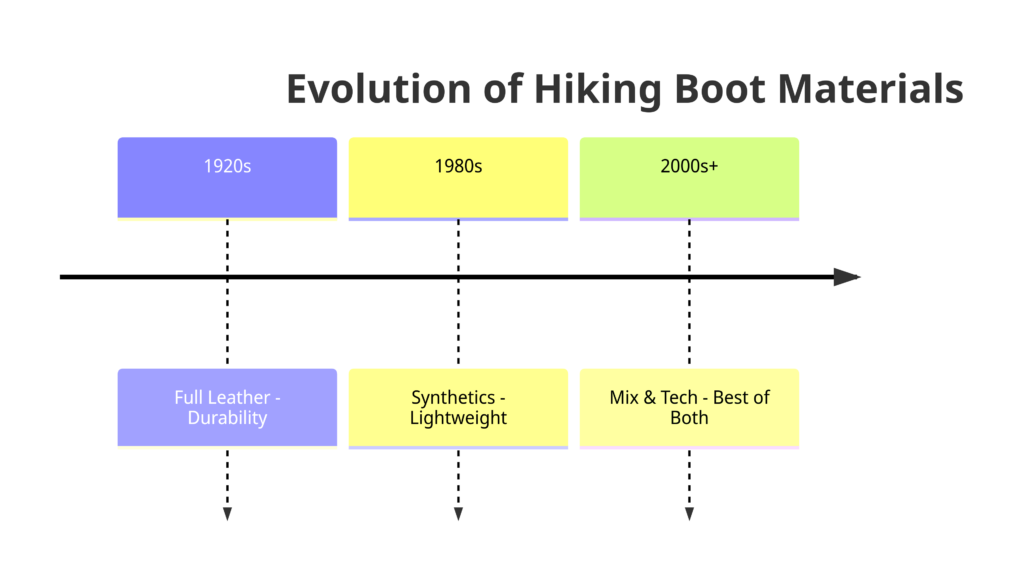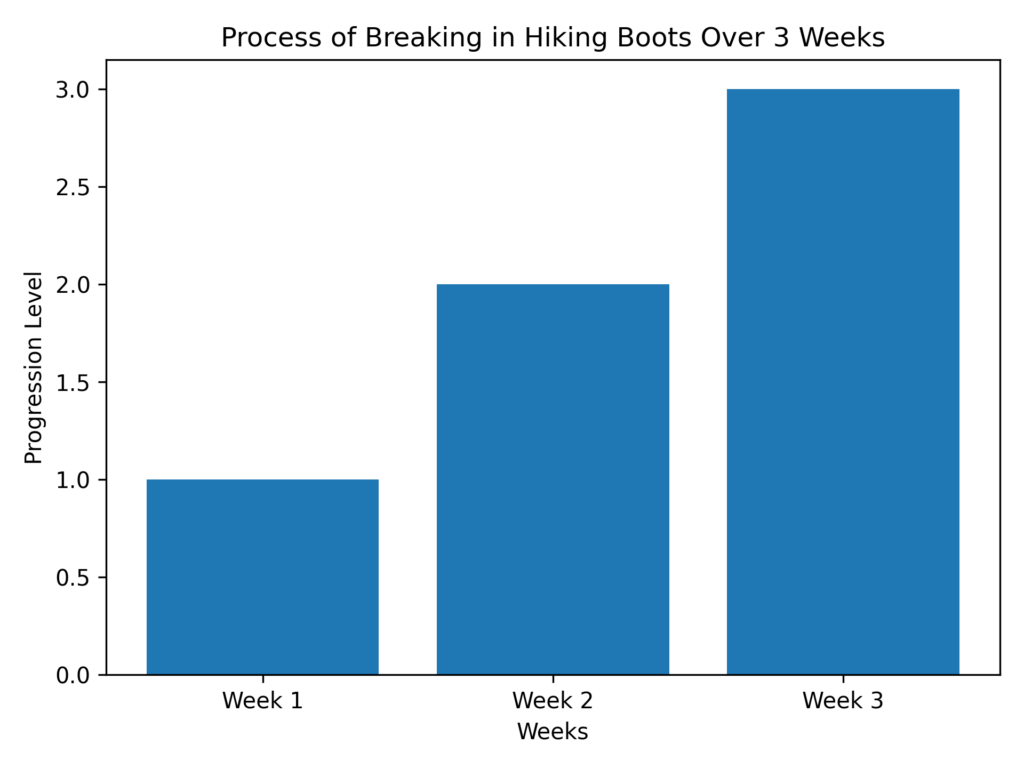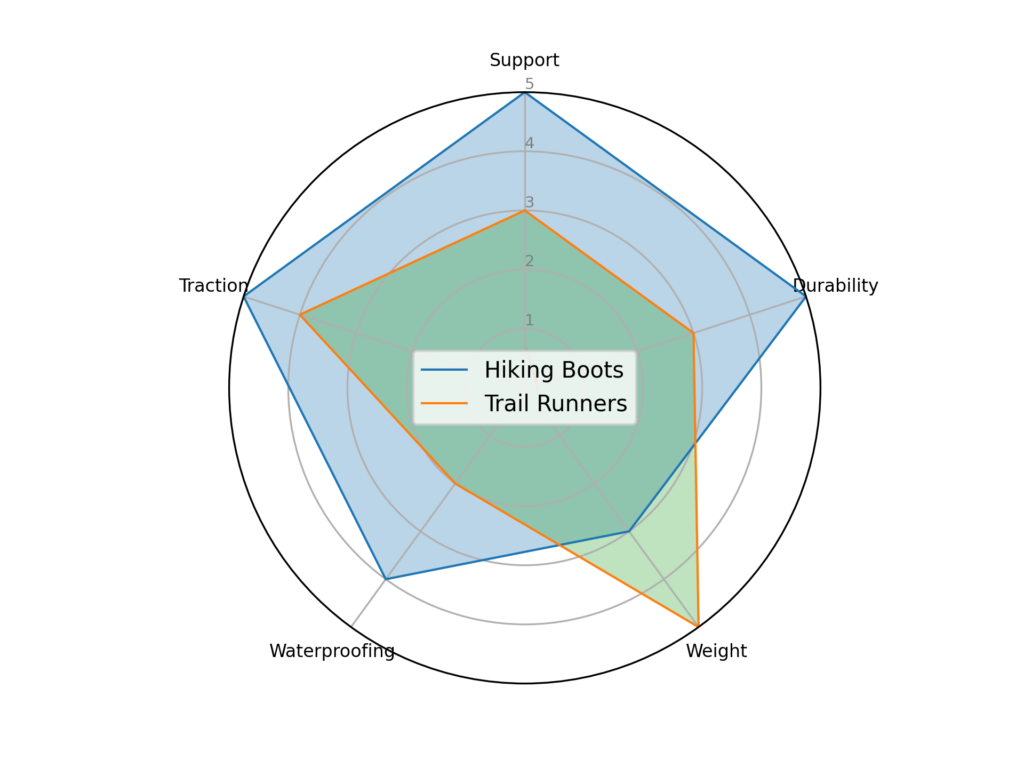Introduction
Hiking boots. They’re not just another footwear fad. They’re the unsung heroes of every mountain ascent, forest trail, and rocky terrain you’ve ever dared to tread. Without them, your feet would tell a very different (and likely painful) tale.
Every hiker knows the dread of an ill-fitting boot, or the blisters that come as an uninvited souvenir from a day on the trail. This guide? It’s the solution to all that. Dive in and discover the importance of finding the right boot, and the adventure that awaits!
Table of Contents
The Evolution of the Hiking Boot
The USA’s side of the story
Back in the Wild West, cowboys weren’t just wrangling cattle. They faced rough terrains daily. But it wasn’t until the National Parks boom and the rise of outdoor leisure activities that hiking boots began to stake their claim. American ingenuity saw the transformation of the traditional work boot into a trail-conquering essential.
Meanwhile in Europe…
Across the pond, Europe had its own story. Here, alpine enthusiasts were the frontrunners. They sought durable, sturdy boots for their mountain escapades. The Swiss Alps, the Pyrenees, the Scottish Highlands – you name it, Europe’s treacherous terrains demanded a boot up to the challenge. And the continent delivered.
Changes in design and materials

Leather was the early favorite. It’s rugged. It’s durable. But as innovation swept in, synthetic materials joined the scene. Lighter, quicker to dry, and often more affordable, these materials revolutionized the hiking boot game. It’s not just about the exterior; from Gore-Tex linings for waterproofing to breathable mesh designs, hiking boots have come a long way.
| Era | Material | Benefit |
|---|---|---|
| 1920s | Full Leather | Durability |
| 1980s | Synthetics | Lightweight |
| 2000s+ | Mix & Tech | Best of Both |
Facing up to other challenges
Terrain isn’t the only test. Hiking boots had to evolve to withstand torrential downpours, scorching heat, and the occasional stream crossing. There were also the hikers’ demands: some wanted ankle support; others demanded lightweight designs. Manufacturers had to strike a balance – and boy, did they step up!
New designs developed

Function met fashion. As urban trekking and trail fashion found its place in city streets, hiking boots had another terrain to conquer: style. From neon laces to stylish designs, hiking boots aren’t just for trails anymore. They’re for anyone with a spirit of adventure, whether in the mountains or the urban jungle.
How to Choose Hiking Boots – Understanding the Basics
Video: Hiking Boot Basics
For those who prefer a visual guide, we’ve got you covered! 📹 This quick video takes you through the nitty-gritty of hiking boots, ensuring you know your uppers from your outsoles.
How Shoe Categories Help You
Not all trails are created equal, and neither are hiking boots! By classifying boots into different categories, you can easily pinpoint which is ideal for your adventure.
- Lightweight: Perfect for those gentle forest strolls.
- Mid-weight: Think weekend getaways in rugged terrains.
- Heavyweight: Everest, here we come!
Pro-tip: Always consider the weight of your backpack. A heavier pack might require a sturdier boot category!
Sneak Peak – The 5 Key Tips
- Know Your Terrain: Rocky, muddy, or snow-clad? Different terrains demand different boots.
- Test for Comfort: Wear ’em, walk ’em, and, yes, dance in them if you must!
- Weather Matters: Waterproof boots for rain, breathable ones for summer.
- Toe Wiggle: Your toes should have room to move but not slide.
- Sock It Right: Always test boots with the socks you plan to hike in.
Hiking Boot Sizing – All You Need to Know
A hiking boot that doesn’t fit is a recipe for blisters! 🚫
Size Does Matter: Don’t just go by your regular shoe size. Always measure!
- Length: Ensure a thumb’s width between your toe and the boot’s end.
- Width: The ball of your foot should fit snugly, without squeezing.
| Remember | Why it Matters |
|---|---|
| Test with hiking socks | Ensures a true fit on the trails. |
| Evening is measuring time | Feet can swell during the day! |
| Different brands, different fits | Always try before you buy. |
When in doubt, head to a specialized store. Expert advice and in-store trials can be game-changers!
Types of Hiking Boots
Ready to unravel the mystery behind hiking boot categories? Spoiler: It’s all about the terrain. 🌲🏔
Categories A to D: The Complete Overview
“As a general rule, the tougher the terrain, the stiffer the soles of your footwear.” Got that? Cool. Now, let’s decode these categories:
- Category A: For your casual park strolls and city escapes.
- Category B: Slightly rugged terrains? Grab these.
- Category C: Say hello to high-altitude treks and rocky landscapes.
- Category D: Mount Everest, here we come!
Hiking boots vs. hiking shoes – category overview
Here’s a handy dandy cheat sheet:
| Category | Main Attributes | Areas of Use | Tours |
|---|---|---|---|
| A | Lightweight, flexible | Parks, streets | Day trips |
| B | Moderate support | Hills, valleys | Weekend adventures |
| C | Rigid, insulated | Mountains, glaciers | Extended trekking |
| D | Ultra-rigid | High-altitude peaks | Professional mountaineering |
Special case: Category C mountain footwear
A unique beast in the hiking world! Perfect for those who are trekking to higher altitudes but aren’t exactly scaling Mount Everest. Think more Kilimanjaro! They’re built for ruggedness and can handle crampons for icy stretches. Cool, right? ❄️🏔
What are lightweight hiking boots?
Dreaming of floating over trails like a leaf on the wind? 🍃 Lightweight hiking boots are your pick! They’re perfect for those who prioritize speed and efficiency over ruggedness. Ideal for short getaways and valley trails.
Determining which boots are right for you
Your feet are as unique as your hiking dreams. But finding the perfect boot isn’t just about size; it’s about fit, terrain, and purpose. Before you swipe that card, ask yourself:
- Where am I headed? Beach, mountain, forest?
- How long is my trek? A day, a weekend, a fortnight?
- What’s the weather like? Snow, rain, sun?
- Am I a casual stroller or a trail conqueror?
Then, try them on! A boot that feels good in the store will feel great on the trail.
Anatomy of a Hiking Boot (Hiking Boot Components)
Buckle up, explorers! Let’s dissect your trusty hiking boots and uncover the magic within. Just like our bodies, every part of a hiking boot has a special role to play.
Hiking Boot Uppers
The upper is the top part of the boot that wraps around your foot. It’s the protective shield against outside elements.
Materials used:
- Leather: Durable and water-resistant, but may need a break-in period.
- Synthetic: Breathable and lighter than leather, but might wear out faster.
Key features:
- Tongue: Keeps debris out.
- Lacing system: Secures the boot on your foot.
Hiking Boot Midsoles
Think of the midsole as your boot’s cushioning system. It’s what separates your foot from rough terrain and provides comfort.
Materials:
- EVA: Lightweight and cushier.
- PU (Polyurethane): Firmer and more durable.
Hiking Boot Internal Support
This is the boot’s skeleton, giving it structure and stability. There’s often a shank (a stiff insert) and a plate (a thin, flexible material) beneath the midsole to shield your feet from getting bruised by sharp objects.
Hiking Boot Outsoles
The boot’s sole! It’s all about grip and traction here.
Features:
- Lug pattern: Deep, thick lugs grip better on rough terrains.
- Heel brake: Reduces the chances of sliding during steep descents.
Crampon Compatibility
Planning an icy or snow-filled adventure? Crampon compatibility is crucial. It’s all about how your boot can attach to crampons for extra traction. Remember:
- Step-in crampons: For stiff-soled boots.
- Strap-on crampons: More versatile, fits most boot types.
Importance of Fit in Hiking Boots
Let’s get this straight: A bad fit can break your hike, while a good fit can make you feel on top of the world.
Importance of the right fit
A boot that fits well:
- Reduces the chances of blisters.
- Increases stability on uneven terrains.
- Enhances overall comfort.
Measuring your foot
Simple steps:
- Wear your hiking socks.
- Stand on a piece of paper.
- Mark the tip of your longest toe and the back of your heel.
- Measure the distance.
- Voila! That’s your foot size.
🔗 Pro-tip: Measure both feet. If they differ, always choose the size that fits the larger foot.
Factoring in sock thickness
Thicker socks = more warmth & cushioning. But, remember:
- Summer hikes: Opt for thinner, moisture-wicking socks.
- Winter treks: Thicker, insulating socks are your friend.
Shop Hiking Boots
When trying on boots:
- Wiggle those toes! Make sure they’re not squished.
- Walk around, preferably on an incline.
- The heel shouldn’t slip.
Women’s vs. Men’s Hiking Boots: The Duel of the Feet!
Did you know that women’s and men’s feet are like apples and oranges? They’re different in unique ways. Let’s dive into the nitty-gritty and uncover the mystery behind the gender divide in hiking boots!
Table: Footwear Face-Off
| Aspect | Women’s Boots | Men’s Boots |
|---|---|---|
| Fit | Designed with a narrower heel and wider forefoot | Wider overall fit |
| Flexibility | Generally more flexible | Tend to be stiffer |
| Design & Color | More variety in color & patterns | Often more neutral tones |
| Weight | Often lighter due to materials & design | Generally heavier |
Key Takeaway: It’s not about gender but the perfect fit! Always try before you buy.

Waterproof vs. Non-Waterproof Boots: Splash or Pass?
Imagine hiking in wet conditions without waterproof boots. Yikes! But wait, do you ALWAYS need them? Let’s splash into the debate!
List: Waterproof Wonders
- Pro: Your feet remain dry. No more squishy steps!
- Pro: Perfect for unpredictable weather.
- Con: Less breathable, which can mean sweaty feet.
- Con: Generally pricier.
List: Non-Waterproof Wonders
- Pro: Highly breathable. Your feet can actually breathe!
- Pro: Dries quicker if they do get wet.
- Con: Rain? Streams? Wet grass? You might get a surprise foot bath.
- Con: May need more maintenance to resist water.
Spoiler Alert: There’s no one-size-fits-all. Consider the terrain, climate, and your tolerance for wet feet.
Caring for Your Hiking Boots: Because They’re Your Sole-mates!
Your boots take you to incredible places. It’s payback time! Show them some TLC.
Cleaning after hikes
- Knock boots together to remove mud.
- Use a soft brush for the outsole.
- For the uppers, a damp cloth works wonders.
Storage tips
- Cool, dry place? Perfect!
- Stuff with newspaper to keep their shape.
- No direct heat. They hate hairdryers!
Waterproofing and maintenance
- Leather boots: Condition once in a while.
- Synthetic boots: Occasionally use a water repellent spray.
Golden Rule: Care for your boots, and they’ll care for your feet. It’s a two-way street!
Unlocking The Secrets of Your Hiking Boots!
Wondering how to make the most of those spanking new hiking boots? Unlock the secrets below!
5 Reasons for Hiking Boots Made of Leather
List: Leather Love
- Durability: Like fine wine, they age well!
- Natural Water Resistance: A splash ain’t no thing.
- Breathability: Your feet will thank you.
- Moldability: Shapes to your feet over time.
- Timeless Look: Fashion meets function.
How to Break In Hiking Boots

No one likes blisters. Period. Here’s how to avoid them:
- Week 1: Wear them at home for an hour daily.
- Week 2: Up the ante. Take short walks outside.
- Week 3: Tackle longer strolls and gentle hikes.
- Remember: Patience is key. It’s a relationship in the making!
How to Choose the Best Socks for Hiking Boots
- Material: Merino wool is a game-changer.
- Thickness: Match with boot type & weather.
- Seam placement: Avoids blisters.
Lacing Techniques: Tie Your Way to Triumph!
Ever thought the way you tie can transform your hike? Think no more. Act!
Table: Lacing 101
| Terrain | Technique | Why It Works |
|---|---|---|
| Steep Ascents | Lock Lacing | Extra ankle support |
| Downhill | Window Lacing | Relieves pressure on the top of the foot |
| Wide Forefoot | Gap Lacing | Provides extra room |
The right knot can prevent a lot of unnecessary foot drama.
Importance of Insoles and Orthotics: Like a Hug for Your Feet!
If your boots are the bread, think of insoles as the jam!
- Memory foam insoles: A pillow for your feet.
- Gel insoles: Great for shock absorption.
- Custom orthotics: Designed just for your unique feet.
Did You Know?: Upgrading your insoles can prolong the life of your boots and your love for hiking.
Walking the Earth-Friendly Way: Hiking Boots and the Planet
Hey, fellow wanderer! Ever thought of the footprints we leave behind? No, not on the trail, but on Mother Earth?
- Materials Matter: Synthetic boots? They might take centuries to decompose! Opt for natural materials.
- Production Cost: Not just $$$, but the carbon footprint, water usage, and more.
- Upcycling Wonders: Some brands now recycle tires and plastic bottles for boots. Cool, huh?
Eco-Tip: Look for certifications like “Organic”, “Fair Trade”, and “Rainforest Alliance” when shopping!
Boost Your Boots: Essential Accessories!
It ain’t just about the boots, but the bells and whistles too.
a. Gaiters
- Guard Up: Mud, snow, rain? Gaiters got your boots covered. Literally.
- Pro-Tip: Pair ’em with tall boots for snowy terrains.
b. Laces
- Colors & Strength: Reflect your style and keep those boots snug.
- Did You Know?: Changing your laces can transform boot fit and comfort.
c. Waterproofing Sprays
- Stay Dry: Because no one likes the squish of a soggy boot.
- Remember: Reapply regularly, especially after rainy hikes.
Bidding Farewell to Old Companions: When’s Goodbye Time?
Ever clung to those old, trusty boots? Sometimes, it’s hard letting go. But here’s the catch:
- Tales of Tread: If the sole looks like your grandpa’s bald head, it’s time.
- Creaks & Leaks: Every puddle seeping in? Your boots are crying for retirement!
- Support No More: If your feet hurt post-hike, the support might’ve waved bye.
Quick Check: Press the boot’s sole. If you feel the ground, the midsole’s done!
Boot ER: DIY Fixes to the Rescue!
Your boots looking a bit under the weather? No need for a boot funeral yet. Bring ’em back to life:
Sole Separation
- Glue It!: Strong adhesive like Shoe Goo can seal the deal.
- Pro-tip: Clean the area and let it dry before gluing.
Minor Holes & Tears
- Patch Up: Use a boot patch kit or even duct tape as a temp fix.
- Reminder: It’s a quick fix. Consider professional repairs for longevity.
Worn Out Laces
- Swap: Sometimes, fresh laces rejuvenate the entire boot.
The Eternal Debate: Hiking Boots vs. Trail Runners
Here’s the tea, folks:
Table: Boot Battle – Who Wins?
| Criteria | Hiking Boots | Trail Runners |
|---|---|---|
| Support | High ankle support, sturdy | Lightweight, flexible |
| Durability | Built to last rough terrains | Might wear out faster on tough trails |
| Weight | Heavier | Light as a feather |
| Waterproofing | Generally better | Quick-drying, less water-resistant |
| Traction | Grippy for rugged trails | Great for well-maintained paths |

From the Mountaintops: Expert Insights on Hiking Boots
Ever wondered what the pros think? We asked Ingo Wilhelm, a trail legend, and other seasoned hikers for their golden nuggets.
“A hiking boot is more than gear; it’s your trusted companion.” – Ingo Wilhelm
What the Pros Say:
- Durability is King: Most experts prioritize long-lasting wear over fancy features.
- Function over Fashion: While neon greens and bright blues are fun, it’s the boot’s function that’ll get you through the hike.
- Foot Love: Ingo stresses, “Invest time in finding the right fit. Your feet will thank you.”
Dive Deeper: Related Reads & Articles
Get your reading glasses on! Here’s what’s buzzing in the hiking world:
- “Mountain Marvels” – A deep dive into the history of hiking footwear.
- “Trail or Tarmac” – The debate between hiking boots and running shoes continues.
- “Waterproof Wonders” – Is waterproofing a boon or a bane? Explore with us.
The Final Step: Lacing Up Our Thoughts
Embarking on a hiking journey is more than just the view at the peak; it’s about every rock, puddle, and path on the way. The right boot doesn’t just cushion your foot; it amplifies the experience. Don’t just choose a boot; choose a partner for your journey.
As Ingo reminds us, “Every step in nature is a story, make sure your feet narrate it well.”
So, lace up, stride with confidence, and let every trail be a tale worth telling.
Frequently Asked Questions (FAQs) About Hiking Boots 🥾❓
1. Why are hiking boots so important for trekkers?
Hiking boots provide support, grip, and protection. They safeguard your feet from rough terrains, keep them dry in wet conditions, and help in reducing the risk of injuries.
2. Can I use regular sneakers for hiking?
While sneakers might be comfortable for light walks, they lack the support, grip, and protection needed for uneven terrains. For serious hiking, investing in a good pair of hiking boots is essential.
3. How often should I replace my hiking boots?
It largely depends on usage. However, if you notice reduced support, grip, or discomfort, it’s probably time for a new pair. Generally, after 500-700 miles, consider checking them for wear and tear.
4. Are waterproof boots always the best choice?
Not necessarily. While waterproof boots are great for wet conditions, they might lack breathability. Consider the climate and terrain of your hiking spot before deciding.
5. How do I break in my new hiking boots?
Start by wearing them around the house. Gradually use them for short walks, then longer treks. Always wear hiking socks during this process to avoid blisters.
6. Is there a difference between men’s and women’s hiking boots?
Yes, the primary difference lies in the design catering to the general foot shape and size of each gender. However, choose what fits you best, irrespective of gender labeling.
7. What’s the deal with insoles and orthotics?
They provide additional comfort, support, and foot alignment. Especially if you have foot issues, custom insoles can be game-changers.
8. How do I care for my hiking boots?
Post-hike, clean off mud and dirt. Store in a cool, dry place. For leather boots, consider conditioning. If waterproofing wanes, use a waterproofing spray.
9. Laces seem trivial. Are they?
Not at all! Laces can affect fit, support, and even reduce fatigue. Consider sturdy laces and learn different lacing techniques for varying terrains.
10. Any quick tip before my first big hike?
Always break in your boots before the actual hike. Your feet will thank you later!